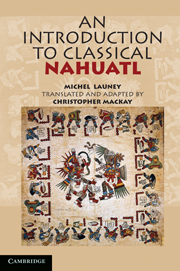Book contents
- Frontmatter
- Contents
- Preface
- How to Use This Book
- PART ONE
- PART TWO
- Lesson Sixteen Agent Nouns, the -ni Form
- Lesson Seventeen Compound Nouns, Verbal Incorporation
- Lesson Eighteen Bitransitive Verbs, Ambitransitive Verbs
- Lesson Nineteen Causative Verbs
- Lesson Twenty Applicative Verbs
- Lesson Twenty-One Honorific and Deprecatory Verbs
- Lesson Twenty-Two Pluperfect, Counterfactual, Vetitive, Directional Conjugations
- Lesson Twenty-Three Morphological Peculiarities of Certain Nouns and Verbs
- Lesson Twenty-Four More on Locatives
- Lesson Twenty-Five More on Quantifiers
- Lesson Twenty-Six Details about Number and Person, Indefinite Pronouns and Adverbs
- Lesson Twenty-Seven Compound Verbs
- Lesson Twenty-Eight Reduplication outside of the Plural, More on Verbs
- Lesson Twenty-Nine Derivative Verbs
- Lesson Thirty Derivative Nouns
- Lesson Thirty-One Noun Clauses
- Lesson Thirty-Two Attributives, Relative Clauses, Copula Verbs, Semi-Auxiliaries
- Lesson Thirty-Three Comparisons, Clauses of Result, Purpose and Cause
- Lesson Thirty-Four Conditions, More Particles
- Lesson Thirty-Five Temporal Clauses, Particles, Interjections
- Appendix One Traditional Orthography
- Appendix Two The Aztec Calendar
- Appendix Three Inflexional Patterns
- Appendix Four Key to the Exercises
- Nahuatl-to-English Vocabulary
- English-to-Nahuatl Vocabulary
- Index
Lesson Eighteen - Bitransitive Verbs, Ambitransitive Verbs
Published online by Cambridge University Press: 05 June 2012
- Frontmatter
- Contents
- Preface
- How to Use This Book
- PART ONE
- PART TWO
- Lesson Sixteen Agent Nouns, the -ni Form
- Lesson Seventeen Compound Nouns, Verbal Incorporation
- Lesson Eighteen Bitransitive Verbs, Ambitransitive Verbs
- Lesson Nineteen Causative Verbs
- Lesson Twenty Applicative Verbs
- Lesson Twenty-One Honorific and Deprecatory Verbs
- Lesson Twenty-Two Pluperfect, Counterfactual, Vetitive, Directional Conjugations
- Lesson Twenty-Three Morphological Peculiarities of Certain Nouns and Verbs
- Lesson Twenty-Four More on Locatives
- Lesson Twenty-Five More on Quantifiers
- Lesson Twenty-Six Details about Number and Person, Indefinite Pronouns and Adverbs
- Lesson Twenty-Seven Compound Verbs
- Lesson Twenty-Eight Reduplication outside of the Plural, More on Verbs
- Lesson Twenty-Nine Derivative Verbs
- Lesson Thirty Derivative Nouns
- Lesson Thirty-One Noun Clauses
- Lesson Thirty-Two Attributives, Relative Clauses, Copula Verbs, Semi-Auxiliaries
- Lesson Thirty-Three Comparisons, Clauses of Result, Purpose and Cause
- Lesson Thirty-Four Conditions, More Particles
- Lesson Thirty-Five Temporal Clauses, Particles, Interjections
- Appendix One Traditional Orthography
- Appendix Two The Aztec Calendar
- Appendix Three Inflexional Patterns
- Appendix Four Key to the Exercises
- Nahuatl-to-English Vocabulary
- English-to-Nahuatl Vocabulary
- Index
Summary
Introduction to Bitransitive Verbs
In English, there are verbs that take two objects, a direct and an indirect object: ‘I gave the waiter a tip’, ‘I cooked him dinner’. The direct object is the thing (seldom a person) that the verb directly acts upon. The indirect object is usually an animate being for or to whom the action is done. The indirect object can be expressed in two ways. Both the direct and indirect objects sometimes appear a simple nouns or pronouns, and in this case, the indirect object precedes the direct one (as in the examples given). The indirect object can also be indicated with the prepositions ‘for’ or ‘to’, in which case it follows the direct object: ‘I gave a tip to the waiter’ or ‘I cooked dinner for him’. In terms of Nahuatl grammar, we might term the indirect object the beneficiary (this term is to be understood broadly, as the indirect object may be harmed rather than benefited by the action). In these instances, the Nahuatl verb can take two objects, one representing the regular direct object and the other the beneficiary. Such verbs are called bitransitive. Unlike the case with English, where word order clearly distinguishes which is which when the beneficiary appears without the preposition, the bitransitive verbs in Nahuatl make no such formal distinction. In the natural order of things, the direct object will be inanimate and the beneficiary animate, but this is by no means always the case.
- Type
- Chapter
- Information
- An Introduction to Classical Nahuatl , pp. 178 - 188Publisher: Cambridge University PressPrint publication year: 2011



